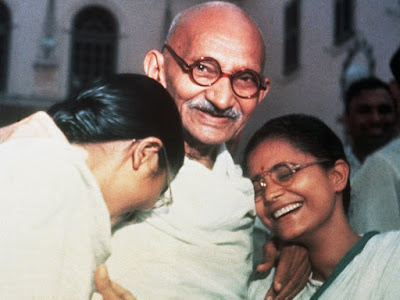We may never be strong enough to be entirely nonviolent in thought, word and deed. But we must keep nonviolence as our goal and make strong progress towards it. - Mohandas Gandhi
 |
| Mohandas Gandhi |
The United Nations has designated October 2nd as International Day of Non-Violence. This date was chosen to reflect on this profound idea since Mohandas Gandhi was born in India on October 2, 1869. According to the United Nations, Gandhi was the "leader of the Indian independence movement and a pioneer of the philosophy and strategy of non-violence."
On September 11, 1906 in South Africa, dissatisfied with the term passive resistance to describe nonviolence he convened a contest that resulted in a new word "Satyagraha" derived from Sanskrit that Gandhi described as follows: "Truth
(Satya) implies love, and firmness (agraha) engenders and
therefore serves as a synonym for force."
Monday, October 2nd is the day to share the message of nonviolence
through education and awareness. It is a powerful idea that recognizes
the dignity and power inherent in each individual, while at the same
time recognizing that harnessing force through disciplined, strategic
and non-violent action magnifies the power of the individual and when
working in concert with others can become an unstoppable force for
positive change. The life and example of Congressman John Lewis, who passed away in 2020, is an example of this.
Critics often cite that both Mohandas Gandhi and Martin Luther King Jr. were assassinated, and that this demonstrates the failure of their nonviolent philosophy, but they fail to look at what they accomplished in the wider societies they inhabited, and their respective legacies decades later. Both changed their respective countries. Gandhi achieved Indian independence, and King ended official segregation, empowered African Americans with their full voting rights, and achieved much more.
Gene Sharp who also taught generations of activists that there was an alternative to bloody conflict
and that it was non-violent armed conflict. He demonstrated, as both Gandhi and King understood and practiced, that there
was nothing passive about nonviolent resistance and that it also
required strategy to increase the odds of success in a struggle. In 1990
at the National Conference on Nonviolent Sanctions and Defense in Boston, Gene Sharp succinctly outlined his argument.
"I say nonviolent struggle is armed struggle. And we have to take back that term from those advocates of violence who seek to justify with pretty words that kind of combat. Only with this type of struggle one fights with psychological weapons, social weapons, economic weapons and political weapons. And that this is ultimately more powerful against oppression, injustice and tyranny then violence."
This idea has extended to many places, and cultures around the world, but it is co-existing in conflict with ideologies like Marxism-Leninism that are based in class struggle, revenge redefined as justice, and violence exalted as a superior tool of struggle. Both Gandhi and King saw the latter approach as extremely counterproductive.
Michael Nagler, a long time non-violence scholar, presents this idea as follows: Nonviolence sometimes “works” and always works, while by contrast, Violence sometimes “works” and never works. Nagler offers a more detailed explanation.
The exercise of violence always has a destructive effect on human relationships even when, as sometimes happens, it accomplishes some short-term goal. The exercise of nonviolence, or Satyagraha, always brings people closer. This explains why Gandhi, after fifty years of experimentation in every walk of life, could declare that he “knew of no single case in which it had failed.” Where it seemed to fail he concluded that he or the other satyagrahis had in some way failed to live up to its steep challenge. Taking the long view, he was able to declare that “There is no such thing as defeat in non-violence. The end of violence is surest defeat.”
Below are several videos that introduce nonviolence and how it works. Please share them with others.
Groundbreaking New Study: The Role of External Support in Nonviolent Campaigns (ICNC Webinar)
“Hope, in this deep and powerful sense, is not the same as joy that things are going well, or willingness to invest in enterprises that are obviously headed for early success, but rather an ability to work for something because it is good, not just because it stands a chance to succeed. The more unpromising the situation in which we demonstrate hope, the deeper that hope is. Hope is not the same thing as optimism. It is not the conviction that something will turn out well, but the certainty that something makes sense, regardless of how it turns out.





No comments:
Post a Comment